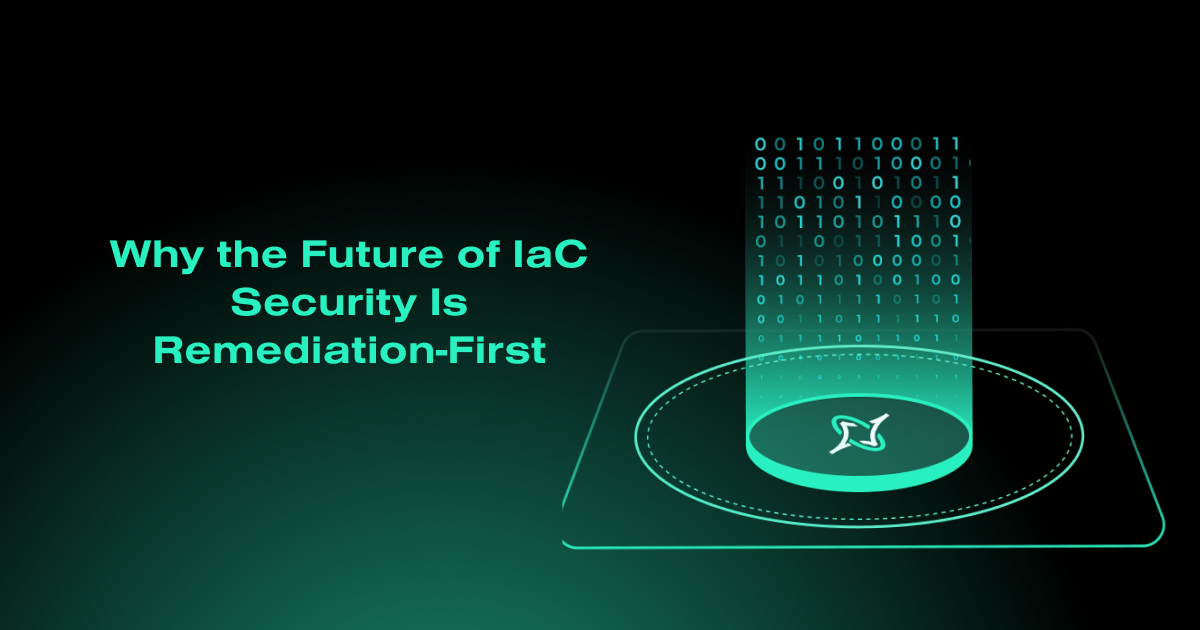
Most Infrastructure-as-Code (IaC) security tools tell you what’s broken. No one tells you how to fix it or, better yet, fix it for you.
That gap between detection and action has quietly become one of the biggest drains on developer time and security team morale. Thousands of misconfigurations pile up in Jira queues. Security findings linger for months. Compliance teams scramble before every audit to prove progress that never quite sticks.
Gartner calls it out plainly: the market doesn’t need another visibility dashboard. It needs simplification and action.
IaC security has reached a breaking point. The next stage isn’t about scanning more code. It’s about fixing it automatically and safely.
The Broken Toolchain: Too Many Tools, Not Enough Progress
To secure cloud infrastructure today, organizations glue together an exhausting mix of tools. A typical setup might include GitHub Copilot or Gemini for code suggestions, Checkov or Prisma Cloud for scanning, Terraform for provisioning, linters for syntax checking, and half a dozen CI/CD scripts for enforcement.
Each one serves a purpose. Together, they create chaos.
Every addition brings new integrations to maintain, new licenses to pay for, and new points of failure to track. As Gartner observed, most teams spend more time managing their toolchains than securing their infrastructure.
The opportunity isn’t just another specialized product. It’s consolidation without compromise.
Gomboc eliminates this patchwork by unifying scanning infrastructure, policy enforcement, and remediation into a single deterministic system. The result is less friction, fewer tools, and a pipeline that stays secure.
The Shift from Detection to Deterministic Remediation
Traditional scanners and cloud-security posture management (CSPM) tools detect issues but stop there. Policy engines enforce rules, but they can’t apply fixes. Copilots generate suggestions, but their recommendations are inconsistent and often unverified.
Gomboc closes the loop. Its deterministic AI automatically generates precise Infrastructure-as-Code fixes, delivered as ready to deploy code fixes.
As one Gartner analyst put it, “It’s one thing to tell me something doesn’t look right. It’s very different to tell me, here’s the PR to fix it.”
That’s the inflection point for cloud security.
Detection created awareness. Deterministic remediation creates progress.
Consistent, auditable fixes, not creative guesses, build enterprise trust.
Deterministic AI: Why Predictability Beats Possibility
Generative AI tools are powerful but unpredictable. Ask a copilot to remediate an S3 bucket policy and you might get five different answers in five tries. None are guaranteed to match company standards or pass compliance review. And it gets even more creative if you ask it to simply add an S3 bucket to your architecture, but let’s not go there.
Deterministic AI is different.
It doesn’t guess. It encodes provider documentation, security benchmarks, and internal policy controls into a structured knowledge graph. Given the same inputs, it always produces the same verifiable output.
Gartner has emphasized that AI’s value now lies in what it enables that wasn’t possible before, not in novelty for its own sake. Deterministic AI enables what security leaders have always wanted: trust, auditability, and reproducibility.
It’s not “AI-powered.” It’s AI you can prove.
Developers Don’t Need Another Dashboard
Security doesn’t fail because developers don’t care. It fails because security lives outside their workflow.
Most IaC scanners produce reports, dashboards, and tickets that interrupt development and break focus.
Gomboc takes the opposite approach.
It integrates directly into GitOps pipelines, IDEs, and CI/CD systems, where developers work. When a misconfiguration is found, Gomboc generates a pull request with a compliant fix and an explanation of what changed. Developers review, merge, and move on.
No tickets. No context switching. No backlog.
This embedded model gives developers control without extra steps and assures security teams that every merge keeps the environment compliant.
Gomboc meets engineers where they work, not where alerts go to die.
Secure from the Start, Not Just “Shift Left”
“Shift left” was once a rallying cry for DevSecOps, but Gartner advises moving past it. The goal isn’t to move security earlier. It’s to build it in from the beginning.
Gomboc does exactly that by turning security policies, CIS Benchmarks, NIST 800-53, SOC 2, or your own custom controls into code-enforced rules. Every infrastructure change is validated and remediated before it reaches production.
That means compliance isn’t a quarterly exercise; it’s a continuous state.
Security, compliance, and cost optimization happen automatically as code is written, not after deployment.
With deterministic remediation, secure code isn’t an afterthought. It’s the only kind that makes it to production.
Metrics That Matter: MTTR and Defect Escape Rate
When Gartner analysts evaluate operational maturity, two metrics consistently define progress: Mean Time to Remediate (MTTR) and Defect Escape Rate.
Gomboc drives both toward zero.
Automating fixes at the pull-request level shrinks MTTR from weeks to minutes. Enforcing policies directly in code prevents misconfigurations from ever reaching production, slashing the defect escape rate.
For platform teams, this translates into fewer incidents, faster release cycles, and measurable ROI.
Every auto-remediated issue represents hours of manual work avoided and potential breaches prevented.
The math is simple: fewer escaped defects + faster fixes = stronger compliance and lower cost.
The Enterprise Perspective: One Platform, Many Wins
Remediation-first security delivers value across every layer of the organization.
- Developers gain velocity and relief from ticket fatigue.
- Security teams gain continuous, auditable enforcement of policies.
- Platform engineers gain consistency and simplicity with fewer tools, lower spend, and unified governance.
Gartner describes this as a two-part story: improving infrastructure delivery while proving the tangible value of AI.
With Gomboc, that story becomes a reality. The platform eliminates alert noise, embeds compliance into the workflow, and demonstrates measurable operational efficiency through deterministic automation.
Gomboc doesn’t just fix misconfigurations.
It fixes the relationship between Dev, Sec, and Ops.
Embracing Remediation-First Security
Detection alone no longer cuts it.
The next phase of IaC maturity is self-healing infrastructure secure from the start, compliant by design, and continuously improving.
Gomboc’s deterministic AI turns that vision into something practical:
- It learns your environment’s rules.
- It applies fixes automatically, without human rework.
- It keeps infrastructure compliant at the speed of code.
For the first time, teams can trust automation without sacrificing control.
No more drowning in alerts. No more half-fixed findings. No more wondering whether security will slow the next release.
The future of cloud security won’t be measured by how many alerts you find but by how few you have left to fix.
Ready to move from scanning to fixing? Get a demo of Gomboc in action.





